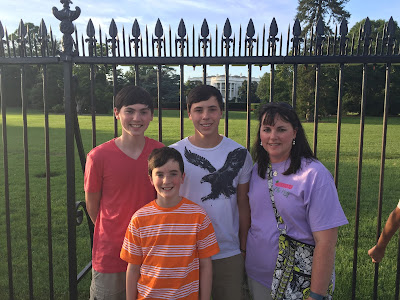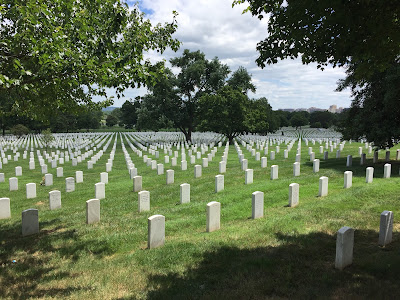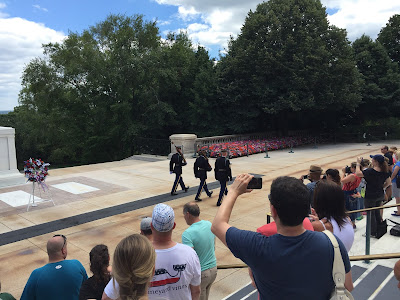My family is headed to Washington D.C. where we will spend a week visiting the monuments and museums on the National Mall while Kim works in the National Gallery of Art. On the way, we decided to visit Lexington, Virginia.
I've been a fan of Thomas Jonathan "Stonewall" Jackson for many years. I have enjoyed watching "Gods and Generals" where Stonewall Jackson's story (that begins just before the Civil War began) was beautifully depicted. I have also enjoyed reading James I. Robertson, Jr.'s massive biography, "Stonewall Jackson: The Man, The Soldier, The Legend." While I would hardly consider myself an expert on General Jackson, I have developed a love and respect for this man that makes me long to spend time with him when we share our eternal reward in Heaven.
Rather than make this a lengthy, wordy blog that recounts our visit in Lexington, I will simply post pictures and put some comments underneath each picture.
 |
This is T.J. "Stonewall" Jackson's home. He lived here from 1851 until he left for the Civil War.
While here, he taught at the Virginia Military Institute which was a half mile walk away.
While visiting here, it felt surreal to stand in the rooms that he occupied about 150 years ago.
|
 |
This picture was taken in the back of Stonewall's home. A garden is visible in the background
that may be very similar to the one he grew while alive.
We were asked by the tour guide not to take any pictures inside. Wish I could have.
|
 |
| If you expand this picture, you can read a brief history of the Jackson house. |
 |
| If you expand this picture, you can read a very concise biography of Stonewall Jackson. |
 |
This is Lexington Presbyterian Church where Jackson attended while in Lexington, VA.
While in Mexico years earlier, Jackson considered the Catholic church. Later, the Episcopalian.
Yet, in the Presbyterian Church, he found a home. Particularly, he agreed wholeheartedly with
their view on predestination. He staunchly believed that God had ordained the events of this life
and that nothing, absolutely nothing, to thwart God's hand. Therefore, he was able to stand bravely
on the battlefield as the bullets pierced the air around him. He believed that if it wasn't his time to
die, he wouldn't. If it was, there was nothing he could do to stop it. So, his bravery was based upon
a deeply theological believe in God's sovereign control of His creation.
|
 |
This monument rests atop Jackson grave and the graves of his close family.
This monument is in the Stonewall Jackson Memorial Cemetery about a third of a mile SW of his house.
|
 |
Couldn't believe I had the opportunity to visit this man's gravesite!
The day of his death is the day of Kim's and my anniversary, May 10th - separated by 134 years.
|
 |
This was the tombstone of his original grave site about 25 yards from his monument.
However, it was later agreed that such a war hero needed a much larger monument. His body, and the
body of some of his family were exhumed and put under the large monument that bears his image.
|
 |
| This is Lee Chapel on Virginia Military Institute's property about a third of a mile from Stonewall's house. |
 |
| This it the plaque that hangs outside the front door of Lee Chapel. |
 |
One may not expect to see President Washington's picture inside of Lee's Chapel.
The explanation is given below in the picture: "Educating to Build and Rebuild a Nation."
|
 |
This picture hangs on the right side of the stage wall of Lee's Chapel. You wouldn't expect to see
such a thing in a chapel, right? Yet, it was made clear that while chapel services occurred frequently during
Lee's time here, it was no longer used for chapel services. Only infrequently did gatherings take place here.
|
 |
The sign on the wall reveals where Robert E. Lee sat during his time as President of Washington College.
|
 |
This recumbent statue of Robert E. Lee was "backstage" from where the pulpit used to be in this chapel.
Noticeably absent were the rebel flags that used to hang on the back corners of this room.
|
 |
This is where Robert E. Lee's body rests in the basement of the chapel.
This area is directly below the recumbent statute.
|
 |
| This picture that hangs on the lower level of the chapel explains what Washington and Lee had in common. |
 |
This picture which also hangs on a wall in the lower level shows how George Washington
and Robert E. Lee were related.
|
Some might ask me, "How can you respect a man who was known only for his valor in serving as a Confederate general?" The answer to that question would take longer than you are willing to read but let me provide four responses:
- First, he was a devout follower of Jesus. He didn't simply claim Christianity - it impacted every area of his life. In fact, as previously mentioned, his valor on the battlefield wasn't simply a part of his character. It was rooted in a deeply-held theological belief of predestination. He believed that God had already ordained the time of his death. So, his task was not to worry about when that time would come, only to be ready when it should overtake him. This is how he could sit atop his horse unafraid as the bullets pierced the air around him.
- Second, he wasn't fighting for slavery. He would have never done such a thing. He was fighting for states' rights. His loyalty was to the state of Virginia. He only wanted to answer to it. He did not want some overarching government, made up primarily of people who did not live in his state nor care about his state, telling his state what to do. (Regarding slavery, he believed it would die of natural causes.)
- Third, his Sunday School class was made up of black children. Further, it was an illegal class - he was teaching them how to read and write which was against the law. He believed that if they learned these skills, he could assist them in their plight in life and even help them to secure their freedom. When he went off to war, he continued to send money back to the Lexington Presbyterian Church to guarantee that the class would continue to teach young black children these needed skills.
- His life was filled with tragedy (too many things to recount here) but he persisted. And, he continued to improve himself. He never gave up. Finally, eventually, he was provided an opportunity for which he had been tailor-made as he served in the Mexican-American War and then the Civil War. When he was shot in 1863 and his left arm had to be amputated only days before his death, Robert E. Lee showed how much he valued his general when he said, "Stonewall has lost his left arm and I have lost my right one."
Well, that ends my reflections on our time at Lexington, VA. I'm looking forward to visiting Washington D.C. and provided even more reflections on the memorials and sights there!















































